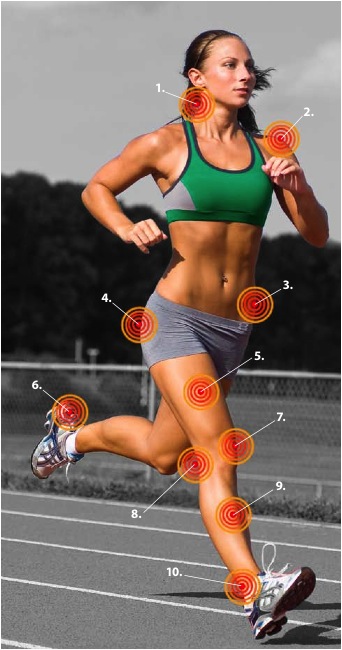A running regimen often reveals the body’s inefficiencies or misalignment. For example, improper foot alignment can cause hip pain, or improper hip alignment can cause knee pain. Physical therapists help runners adjust their running technique, thereby reducing risk of injury and improving race per- formance. Here are some common injuries, pain points, and form issues runners may experience:

1. Neck: Pain in the neck can result from poor running posture. It’s more common in novice runners. Treatments can include improving the running posture by relaxing shoulders, keeping elbows bent at 90 degrees and keep- ing head up, looking forward.
2. Shoulders: Pain in shoulders can result from rounded or protracted shoulders. It’s more common in novice run- ners. Treatments can include scapula strengthening and stabilization exercises.
3. Hip: Hip labral tear is pain located in anterior hip or radiating into groin. Treatments can include specific lower extremity and core strengthening and stabilization exer- cises of the glutes, quads, etc.
4. Buttocks: Piriformis syndrome is pain located in but- tock region, radiating pain down back of thigh to knee may be associated. Treatments can include ice after activity as needed for pain relief.
5. Thigh: muscle strains can be located in calf, thigh or hamstring. Treatments can include active release tech- niques, astym, taping or massage.
6. Heel: Plantar fasciitis is pain located the medial (inner) portion of heel.Treatments can include pain free calf stretching.
7. Knee: Patella femoral syndrome is pain located around the knee cap that increases when going downstairs or down- hill or with prolonged sitting. Treatments can include joint mobilization techniques of hip, ankle and subtalar joint.
8. Knee: ITB syndrome is pain located on the lateral (outer) portion of knee that increases with running. Treatments can include lower extremity and core strengthening and stabilization exercises of the glutes, quads, etc.
9. Shins: shin splints are pain that can be located in 3 dif- ferent compartment—anterolateral, posterior medial, and posterior. Treatments can include ice after activity.
10. Achilles Tendon: achilles Tendonitis is pain located on the achilles tendon. Treatments can include astym and taping.
DISCLAIMER: All information above provided by Michael Conlon, PT, owner of Finish Line PT, New York, NY. This information is a general guide only,. If you have specific questions be sure to discuss them with your health care provider.
Does any of this sound familiar? Consider seeing a physical therapist to evaluate your functional mobility and movement patterns before you experience an injury. A physical therapist can help you recover from most running injuries, and learn how to continue to safely train. A physical therapist can help you become a stronger and smarter runner, which in the long term can help you prevent injury.
Ready to become a stronger and smarter runner? Contact a Physical Therapist today!
[table id=3 /]
Connect